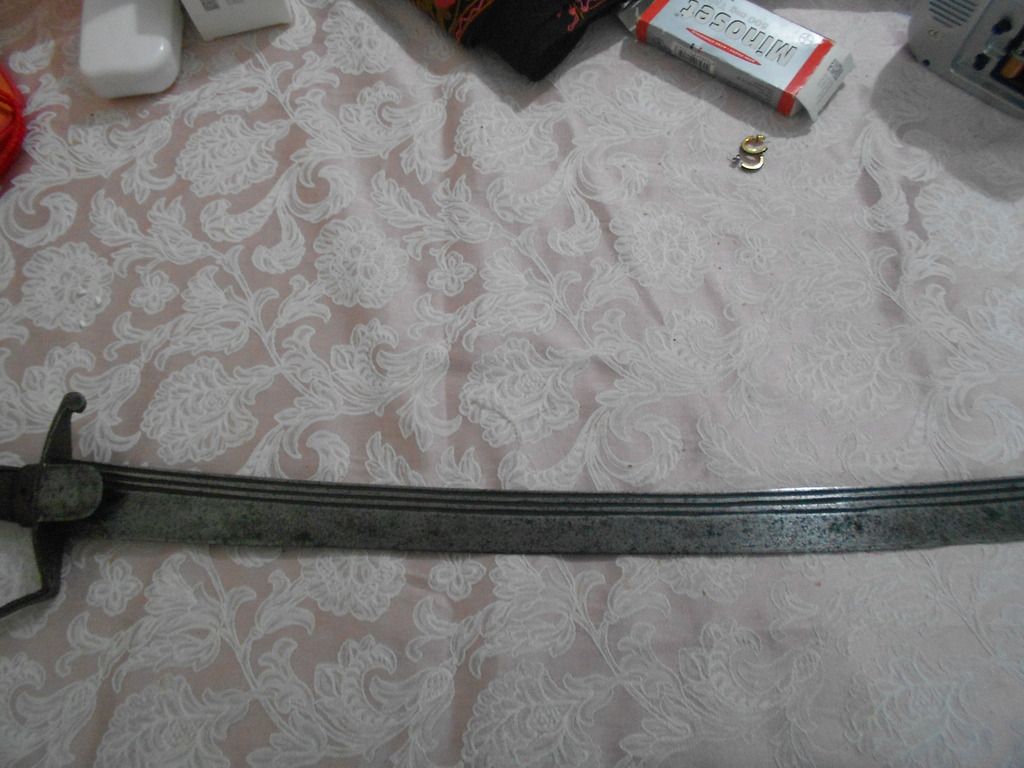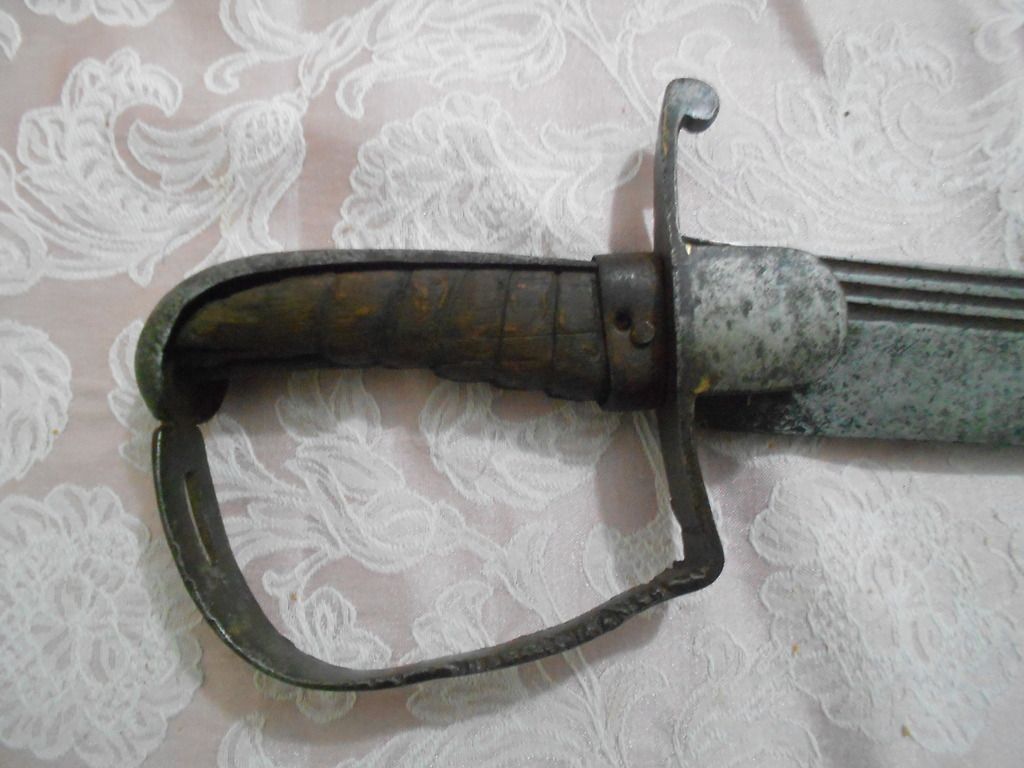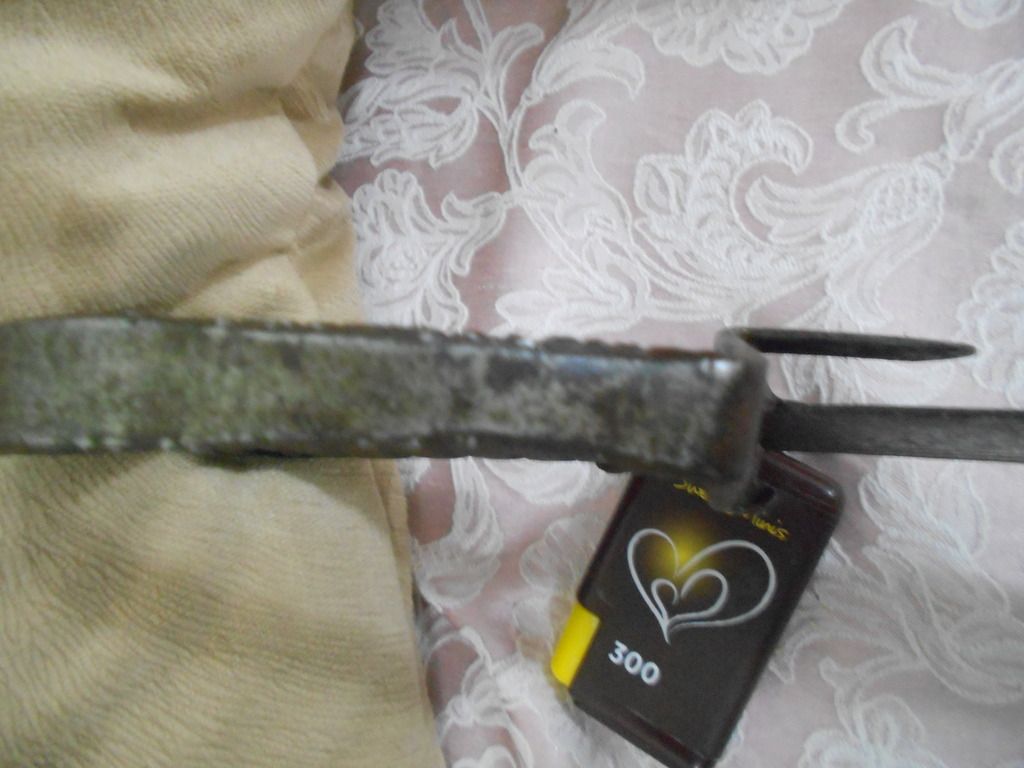
 |
|
|
#1 |
|
Member
Join Date: Sep 2013
Posts: 79
|
Hello gentlemen,
This saber is bought by a friend from a local flea market. He asked me to identify it, but my knowledge on European military sabers is quite limited. It is not in a very good shape but looks like a genuine antique to my uneducated eyes. Yet I failed to find origin or pattern for this saber. Though for some reason, it feels really familiar. Hopefully you guys' deep knowledge on the subject will help me solve this mystery. The saber looks like it is quite worn out from overuse and got crudely repaired (perhaps on the battlefield?). It is a quite a long and wide blade but relatively thin with no kind of T spine. It has a quite simple triangular cross section with three narrow and shallow fullers near the back. There is no visible secondary bevel on the edge. It is still sharp with no visible major damage to the edge despite its thinness. It feels heavy to hold due to high CoG of the saber that points to cavalry usage. The guard and the backstrap are made of steel, and quite solid. One of the langets is broken and the steel knuckleguard shows signs of real abuse, serrated from attacks from another sharp object (the romantic in me wants to believe this is due to many swordfights this blade saw, but who knows?) Tang is is hot peened to the hilt. Knuckleguard came loose in time and crudely repaired by a simple nail used as a rivet. The wooden grip is broken and loose. Overall length : 91 cm Blade length: 79 cm Blade Width: 4 cm the bottom, 3.3 cm at the middle, 3.5 cm near the tip Center of Gravity: 21,5 cm Thickness: 5 mm at the guard tapers to 3 mm in the middle and to almost 1 mm near the tip        
|
|
|

|
|
|
#2 | |
|
Member
Join Date: Jul 2006
Location: Buraimi Oman, on the border with the UAE
Posts: 4,408
|
Quote:
Salaams Sancar... Can you identify which souk it was picked up from?...This looks like a Nimcha style often seen having been fetched into Muscat from Salalah or Yemen...I suspect the rehilt is crude and not the original style at all...I strongly suspect Yemen...Sanaa ....Perhaps the blade is originally German... Regards, Ibrahiim al Balooshi. |
|
|
|

|
|
|
#3 |
|
Arms Historian
Join Date: Dec 2004
Location: Route 66
Posts: 9,738
|
Sancar, nothing wrong with romanticism!! it is what propels the joy of collecting and studying the history of these weapons....as we always say, these arms can indeed talk to us
 The thing about weapons is that their 'working lives' often exceed the normally recognized period of many familiar forms. In this case, the hilt is a stirrup hilt of a British M1796 light cavalry sabre, which were profusely produced and in many cases remained in service decades after they were superceded by another pattern hilt in 1829. The blade, as astutely noted by Ibrahiim, is of an also profusely produced type from Germany, specifically Solingen workshops. I would note that as far as I have known, the notion of 'battlefield repair' is most unlikely with most arms. Crude repairs are typically the work of less than skilled crafters who are 'recycling' available components often in efforts to equip forces in developing circumstances. These kinds of 'hatchet point' German blades were among well known forms used in Arabian context through the 19th century and even into the 20th. In Arabia, it is well known that sabres were used well into the 20th century, long after technically obsolete in most other places. That is where the 'romanticism' can become well placed even in 'reworked' pieces like this.That hilt began its life used in the sabre of a British cavalryman, then at some point ended up probably with broken or unserviceable blade, which was replaced in a small, relatively unskilled circumstance, and furbished with this commonly available blade form, to be used once again in some probably obscure tribal setting. Who knows for sure what true history may be guarded within this sword? |
|
|

|
|
|
#4 |
|
Member
Join Date: Sep 2013
Posts: 79
|
Thank you Jim and İbrahim for your answers.
I made further inquiries on other sword related forums and the general idea about this saber is that it is a German-made trade blade, possibly solingen, with a Prussian 1811 blücher version of the 1796 hilt. Three fullered trade blade is possibly from 18th century and later slightly reshaped in the tip to match the 1796 pattern and rehilted with 1811 blücher hilt. This saber is bought from a flea market in İstanbul. So I deduce this might be an 18th century Prussian blade that was sold to Ottoman army around early 1900s. You can find a lot of 18th to 20th century European military blades from Europe in Istanbul antique shops. |
|
|

|
|
|
#5 | |
|
Member
Join Date: Jul 2006
Location: Buraimi Oman, on the border with the UAE
Posts: 4,408
|
Quote:
Salaams Sancar, Istanbul...That is quite interesting...as I am certain this blade originates in Germany but appears common on various hilts from Yemen etc ...Sanaa is where I many were rehilted. ...which is also no doubt within the range of Istanbul souk purchasing... To give you examples of similar blades collected by Omani souk owners from Yemeni sources...see http://www.vikingsword.com/vb/showth...t=omani+swords in particular the last photo .. Regards, Ibrahiim al Balooshi. |
|
|
|

|
|
|
#6 | |
|
Arms Historian
Join Date: Dec 2004
Location: Route 66
Posts: 9,738
|
Quote:
|
|
|
|

|
 |
|
|